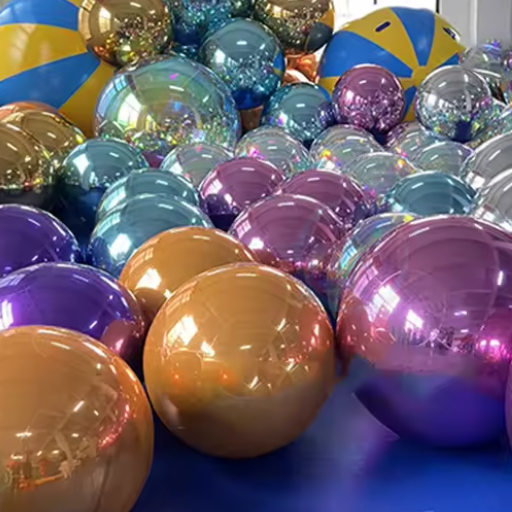Helium balloons have always been a hit as celebration decorations for any event-bit birthday parties, weddings-the list is endless. The way they float around seemingly effortlessly adds a little charm to the event, but-ever wondered how much time they spend being full? Being aware of the lifespan of helium balloons for those grand occasions that you plan will help you create that perfect setting for your photos. The book takes an in-depth look into the factors that affect the longevity of helium balloons, with a few tips to keep them from sinking sooner and the explanation of the formation behind their buoyancy. Whether you perform party planning or are just a curious person, this is an all-inclusive guide for you!
Science Behind Helium Inflation

Helium balloons generally stay inflated for varying amounts of time depending on the balloon’s own material and whatever other agency operates in the environment. In my opinion, latex balloons are usually set adrift for about 8-12 hours, while foil balloons may last anywhere from days to weeks if well sealed. With the use of Hi-Float in latex balloons or by keeping them at colder temperatures, I have seen the duration that they float greatly extended.
Understanding Helium
Helium is a colorless, odorless, and light gas standing in a class by itself on the periodic table under the noble gases. Its unique atomic configuration bestowed upon it certain properties such as inertness and very low density, this which made it ideal for inflating balloons. Given that helium is less dense than air, the gas escapes up through the balloon. And since helium is inert, it will not react adversely to anything-it is thus excellent for use in party decorations and other such applications. On the other hand, because the atom of helium is quite small, it leaves through minute pores in materials such as latex, effectively cutting short the time that these balloons stay inflated. A good knowledge of these properties of helium provides some insight into its role in creating those delightful floating decorations that everyone loves.
How Is a Balloon Filled with Helium?
Filling a balloon with helium makes use of the gas’s unique properties-based on its low density and non-reactive nature. As the helium flows into the deflated balloon, it expands to the full size of the balloon and fills the space evenly. Helium gas molecules have a very light molecular weight unlike air molecules, with a density of about 0.1785 grams per liter at STP, nearly seven times lighter than the density of air. This low density allows the helium to propel any carrying balloon upwards into the air as it displaces the heavier air around it.
In practice, helium tanks supply helium under pressurized conditions to fill balloons. Once helium gets into the balloon, the elastic nature of the balloon material, usually latex or mylar, allows it to stretch and trap the helium gas inside. However, due to helium’s small atomic size, the gas gradually escapes through microscopic pores within the balloon material. The tried-and-tested notions suggest that, typically, latex balloons filled with helium float for about 8 to 12 hours, while foil (mylar) balloons can retain helium and stay afloat for three to five days or even more since the material is less porous.
Why Helium Balloons Float
Helium balloons float because the difference in density between helium and air is quite substantial, and helium is lighter than air. Helium has an atomic mass near that of 4 g/mol, while the average molar mass of air is about 29 g/mol. This difference in density creates an upward buoyant force that allows helium-filled balloons to ascend and float in the air.
The buoyant force exerted on a balloon filled with helium is governed by Archimedes’ principle, whereby the buoyant force acting on the object equals the weight of the air displaced by it. A typical 11-inch latex balloon filled with helium will displace a volume of air very close to 14 liters. The displaced air weighs more than the helium inside the balloon, and this difference in weight, therefore, causes the balloon to rise.
The duration of buoyancy granted to a helium balloon depends entirely on the permeability of the balloon material. Latex balloons allow a quicker escape of helium because they are porous and may only float for 12-24 hours. On the other hand, foil or Mylar balloons, made of less porous materials, can keep helium for days—usually three to five days or more—as it escapes more gradually.
Factors Affecting How Long Helium Balloons Stay Inflated

Some empirical observations suggest that latex balloons float for about 12 to possibly 24 hours while foil or Mylar balloons tend to stay inflated for days, their float times generally ranging from three to five days, sometimes even longer.
Material Differences: Latex vs. Mylar Balloons
The material makes all the difference in the inner workings and the shelf life of helium balloons. Latex balloons are made from natural rubber-a porous material-whereas Mylar balloons are formed from a polyester film endowed with a metallic coating. This difference acts as a huge dividing factor when it comes to the performance of the two types of balloons.
Inflation and Longevity
For helium balloons, latex balloons lose the gas much faster because of their porous structure. Ordinarily, a helium latex balloon of average size would stay filled with gas for about 10-12 hours in the open atmosphere. However, if a special-type surface coating is applied, such as Hi-Float (an aqueous solution made carbonates and water), the float time can be extended up to two or three days. For Mylar balloons, the story is quite different. Here, the material being non-porous retains helium longer with a float duration of three to five days or more, and in some cases, several weeks are possible.
Environmental Impact
Since latex balloons are made of natural products, they are biodegradable and thus will degrade on exposure to sunlight and water; however, if not disposed of properly, they remain a threat to wildlife. Mylar balloons, although more durable, are synthetic and therefore non-degradable. Consequently, their environmental footprint is large. Proper disposal will limit their environmental impact.
Cost and Application
Latex balloons are generally cheaper and thus are very suitable for large-scale short-term programs. The Mylar balloons are generally more expensive but due to their glossy finish and ability to hold printed designs, they are quite suitable for special occasions or long-term displays as they provide a lot of visual appeal and durability.
Temperature and Its Impact on Balloon Life
The role that temperature plays is huge upon the life-span and performance of a balloon. Latex balloons are especially sensitive to temperature fluctuations. A high heat would cause expansion of the air or helium inside a latex balloon, and this would only be detrimental since it tends to over-expand and burst the balloon. Conversely, in cold temperatures, helium contracts; thus, one would notice a great decrease in buoyancy and flight time for the balloons in question. In principle, latex balloons do best at an ambient room temperature level of around 68–72°F (20–22°C).
Being constructed of strong, non-porous material, Mylar balloons tend to be more resistant to temperature change. However, the things could still go wrong with them. For an example, extremes in temperatures could cause weakening of seams on Mylar at elevated temperatures or could cause shrinkage at extremes of cold, affecting their appearance.
Recent studies reported that helium-filled latex balloons would float for 12 hours or so under an ideal set of indoor conditions but start losing helium and deflate within 4 to 6 hours when exposed to high temperatures. In contrast, the Mylar balloons could keep the buoyancy for days or weeks, the period largely dependent upon the conditions of an environment not favourable to their existence.
Environmental Factors to Consider
Balloons warrant consideration for their environmental impact, as should factors that affect their function. Latex balloons, though biodegradable, take anywhere from 6 months to 4 years to decompose, depending upon environmental conditions like exposure to sunlight, temperature, and humidity. So, in the meantime, when they are disposed improperly, they still contribute to litter. Mylar balloons, in stark contrast, are made from nylon coated with metallic substances, thereby rendering them non-biodegradable and a potential menace to wildlife upon improper disposal.
Helium, which is used in inflating balloons in general, is a finite resource with more important applications in medical imaging and scientific research. Studies suggest that conservation of helium is of utmost priority, considering that its excessive use in unnecessary uses (balloons) could push it towards depletion as a resource. Moreover, balloons that are released into the environment can sail for great distances before descending, thus posing a threat to both marine and land animals that may either ingest them or become entangled.
Helium Balloons vs. Other Gases

I believe helium has a great attraction when it comes to balloon gas, for the reason that it is lighter-than-air, and so, it would make a balloon float. Helium being a non-renewable resource requires careful management for its extraction and use. Balloons filled with normal air would not float but have a better option for sustainability, since they do not require helium and can be more easily reused.
Helium and Air: Which One Lasts Longer?
When one considers how long balloons last, it is pertinent to consider how helium and air behave as filling gases. Generally, helium balloons last a relatively shorter time than air balloons. This is because helium, given its minuscule molecular size, passes through the material of the balloon faster. Helium-filled latex balloons usually float for about 8-12 hours, after which they start to deflate. A sealant can be applied to extend the floating duration to around 24 hours. In contrast, foil or Mylar helium balloons can stay afloat for days or weeks, as the materials used are much less permeable.
Air-filled balloons do not float but can last longer, remaining fully inflated for days or weeks given a relatively stable environment. Latex balloons filled with air retain their shape for up to a week within an indoor environment, while foil balloons filled with air could keep their form for several months. This is possible because of lower pressure and slower diffusion rate of air molecules through the balloon material.
Practical Tips for Extending Balloon Life

To protect balloons from being perished, I consider keeping them in a cool indoor environment, free from sunlight, sharp objects, or any warmth. For latex balloons, I sometimes treat them with special spray to prevent oxidation. At the same time, I do not overinflate them and handle them carefully to avoid wear and tear.
Balloon Treatments and Sealants
Balloon treatments and sealants exist to extend the life of the balloons. Those treatments and sealants achieve their life-extending property by diminishing the rate of helium or air escape through the balloon material. One of the most popular treatments is Hi-Float; it is a liquid solution that forms an interior coating inside the balloon which drastically slows down helium leakage.
Unfortunately, untreated latex balloons are by law expected to float for only 12-24 hours, and with an application of Hi-Float, this can be stretched to several days, sometimes crossing the one-week mark under ideal conditions. Foil balloons, on the other hand, have a naturally abundant lifespan extending from one week to one month. In addition, the sealant can still be applied on foil balloons, especially to inhibit durability when deployed outdoors since temperature variations will cause thinning in such materials.
When applying these treatments, it is imperative to coat the solution evenly inside of the balloon before inflation so that the coverage is maximized. This mechanism is very efficient for a lot of occasions, ranging from events and celebrations to long-term displays. When sealants are appropriately applied and the balloons are kept away from extreme heat or sharp objects, balloon longevity can be maximized, wherein, no frequent replacements of balloons would be required.
Ensure Optimal Inflating for Longevity
The correct way of inflating a balloon improves the durability of the balloon and prolongs its life. Balancing the longevity begins with inflating the balloon at its correct recommended size: over-inflation of the material would put undue stress on it, under inflation would make the balloon droop prematurely. The recommended internal pressure should be close to 90% of the balloon’s maximum capacity; therefore, the stretch and resilience of the material are equally balanced, thus reducing stress-induced ruptures.
Once again, experts revealed that using either a hand or electric pump to inflate balloons will have much better results compared to blowing balloons up manually since moisture enters the balloon from man’s breath, thus quickening the deterioration of the balloon material. Another technique is stretching; the balloon should be half inflated and then deflated before actual inflation. The stretching will prepare the elasticity of the balloon.
High-quality regulators aid with helium balloons by allowing them to be filled consistently and prevent helium waste. According to the latest data, helium balloons fill in an optimum room of about 68-72°F (20-22°C) retain their lift ability for an additional 12-24 hours compared to balloons filled in extreme temperatures. Hi-float treatment for helium balloons would be yet another tool for the increased flotation time: untreated balloons floating for an average of 8-12 hours and treated balloons for 48 hours and longer.
Event Balloon Decoration: How to Pick One?
The balloon decorations for events should be chosen in deliberations to match the theme, appearance, and function alongside quality and durability. Balloons come in different types such as latex balloons, foil balloons, and bubble balloons, all with their advantages. For example, latex balloons are biodegradable and come in many colors, making them a conscientious environmental choice and a very versatile option. On the other hand, foil balloons last longer when translated outdoors or for intricate designs, due to their nature and ability to keep heliums well.
In determining sizes, big balloons (e.g., 24-inch or “jumbo”) are great for making a visual statement in an outdoor or large venue, as supported by evidence. Another important thing is an adequately coordinated thematic color palette, tailored to event-specific tones; for instance, metallic gold and silver are top in trend for weddings and formal occasions, while pastel shades are popular selections for baby showers or birthday events.
Reference Sources
-
Balloonatics Party Shop
This source explains the float times for different types of helium balloons, such as latex and foil balloons, and factors that affect their longevity.
Source Link -
One Up Balloons
This page provides detailed float times for various balloon types, including latex, foil, and bubble balloons, along with tips to extend their lifespan.
Source Link -
Balloon HQ
This site offers insights into the inflation duration of helium-filled balloons, emphasizing the impact of size, material, and environmental conditions.
Source Link
Frequently Asked Questions (FAQs)
How long do helium balloons actually stay afloat compared to latex balloons?
Foil helium balloons generally last longer than latex kind. Depending on the material, latex helium balloons usually remain afloat only for 12-24 hours, whereas foil helium balloons retain their buoyancy for several days, maybe even weeks. This characteristic of the material obstructs helium leaks.
What factors affect float time for latex balloons?
Size of balloons, temperature, and sun exposure can affect float time for latex balloons. In cold temperatures, the balloons usually shrink faster, and if the balloons are in the sun, they will begin to lose helium faster.
How can you extend the life of my balloons?
Hi-Float product acts as a barrier inside helium balloons, thus slowing down the leakage of helium through the balloon. Also, inflating the balloons inside rather than outside may prolong the life.
How long do they remain inflated inside?
They stay longer longer if kept indoors, as opposed to placement outdoors. The balloons inside usually last at least 12 to 24 hours soon after which outside weather conditions will affect those outside.
And does bigger balloon float longer?
Yes bigger balloons tend to float longer than smaller ones because the bigger they are, the more helium they hold, which prolongs buoyancy.
Comparing foil balloons to latex balloons?
Foil helium balloons stay way longer than latex ones. While the latex kinds would get deflated within a day, the foil kinds stay inflated for several days or even weeks, hence perfect for decorating occasions that stretch longer.
Key Takeaway
Understanding the factors that affect helium balloon longevity—from material type and temperature to proper inflation techniques—can help you make the most of your party decorations. Whether you choose latex or foil balloons, proper care and treatment can significantly extend their floating time and visual appeal.










